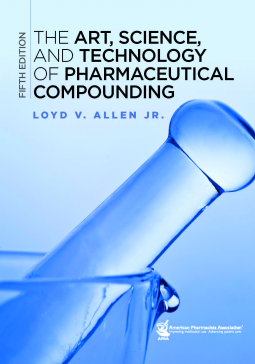
Art, Science, and Technology of Pharmaceutical Compounding, (The) 5th Edition
by Loyd V. Allen
This title was previously available on NetGalley and is now archived.
Send NetGalley books directly to your Kindle or Kindle app
1
To read on a Kindle or Kindle app, please add kindle@netgalley.com as an approved email address to receive files in your Amazon account. Click here for step-by-step instructions.
2
Also find your Kindle email address within your Amazon account, and enter it here.
Pub Date Jul 01 2016 | Archive Date Jan 13 2021
Description
The Art, Science, and Technology of Pharmaceutical Compounding presents in a logical and progressive format all the information that pharmacists and student pharmacists need to understand the purpose and processes of compounding. Author Loyd V. Allen Jr., the preeminent expert, covers basic guidelines, economic and technical factors that compounding pharmacists must consider, and all aspects of good manufacturing practices for compounded medications. In this fifth edition, all chapters have been updated and several significantly revised—particularly “Compounding with Hazardous Drugs”—and three new chapters have been added: “Pharmaceutical Compounding Errors,” “Foams,” and “Compounding with Special Ingredients.” Information on the new law affecting compounding, the Drug Quality and Security Act, is incorporated throughout the book. Chapter 14 now includes information on compounding "films."
KEY FEATURES:
· The initial chapters describe the requisite facilities and equipment, record keeping, calculations, and quality control.
· Three new chapters: “Pharmaceutical Compounding Errors,” “Foams,” and “Compounding with Special Ingredients.”
· Fifteen chapters are devoted to the compounding of each dosage form in turn, from powders and granules to injectables.
· Additional chapters cover veterinary compounding, compounding for special populations, compounding for specific procedures, compounding for clinical studies, compounding cosmetics, compounding with hazardous drugs, and compounding in the event of a natural disaster or terrorist attack.
· Nine appendices provide essential information on the compounding process and examples of standard operating procedures.
· The necessary ingredients and steps are listed for compounding more than 200 sample formulations, including bases, vehicles, and ingredient-specific preparations.
· Updated throughout, including information on the new Drug Quality and Security Act.
AUDIENCE:
Student Pharmacists
Pharmacists who compound medications for patients in community, hospital, and other practice settings
TABLE OF CONTENTS:
Preface
Introduction
Abbreviations and Approximate Solubility Descriptors
1. Guidelines for Compounding Practices
2. Compounding Ingredient Considerations
3. Compounding with Hazardous Drugs
4. Facilities, Equipment, and Supplies
5. Records and Record Keeping
6. Stability of Compounded Preparations
7. Pharmaceutical Compounding Calculations
8. Quality Control
9. Flavors, Sweeteners, and Colors
10. Preservation, Sterilization, and Depyrogenation
11. Powders and Granules
12. Capsules
13. Tablets
14. Lozenges/Troches and Films
15. Suppositories and Inserts
16. Sticks
17. Solutions
18. Suspensions
19. Emulsions
20. Foams
21. Ointments, Creams, and Pastes
22. Gels
23. Ophthalmic, Otic, and Nasal Preparations
24. Inhalation Preparations
25. Parenteral Preparations
26. Biotechnology, Nanotechnology, and Pharmacogenomics
27. Special Populations and Preparations
28. Compounding with Special Ingredients
29. Veterinary Pharmaceuticals
30. Compounding for Clinical Studies
31. Cosmetics for Special Populations and for Use as Vehicles
32. Compounding for Terrorist Attacks and Natural Disasters
33. Pharmaceutical Compounding Errors
Appendix I – Drugs and Dosage Forms Not to be Compounded (The FDA Negative List)
Appendix II – Standard Operating Procedures
Appendix III – Specific Gravity Values of Selected Liquids
Appendix IV – Using Weight-Related Conversion Factors
Appendix V – Sodium Chloride Equivalent Values of Selected Agents
Appendix VI – Buffers and Buffer Solutions
Appendix VII – Allowable Endotoxin Levels in Parenteral Preparations
Appendix VIII – Viscosity-Increasing Agents for Aqueous and Nonaqueous Systems
Appendix IX – Disinfecting Agents Used in Compounding Pharmacies
Index
Available Editions
| EDITION | Hardcover |
| ISBN | 9781582122632 |
| PRICE | $99.95 (USD) |



